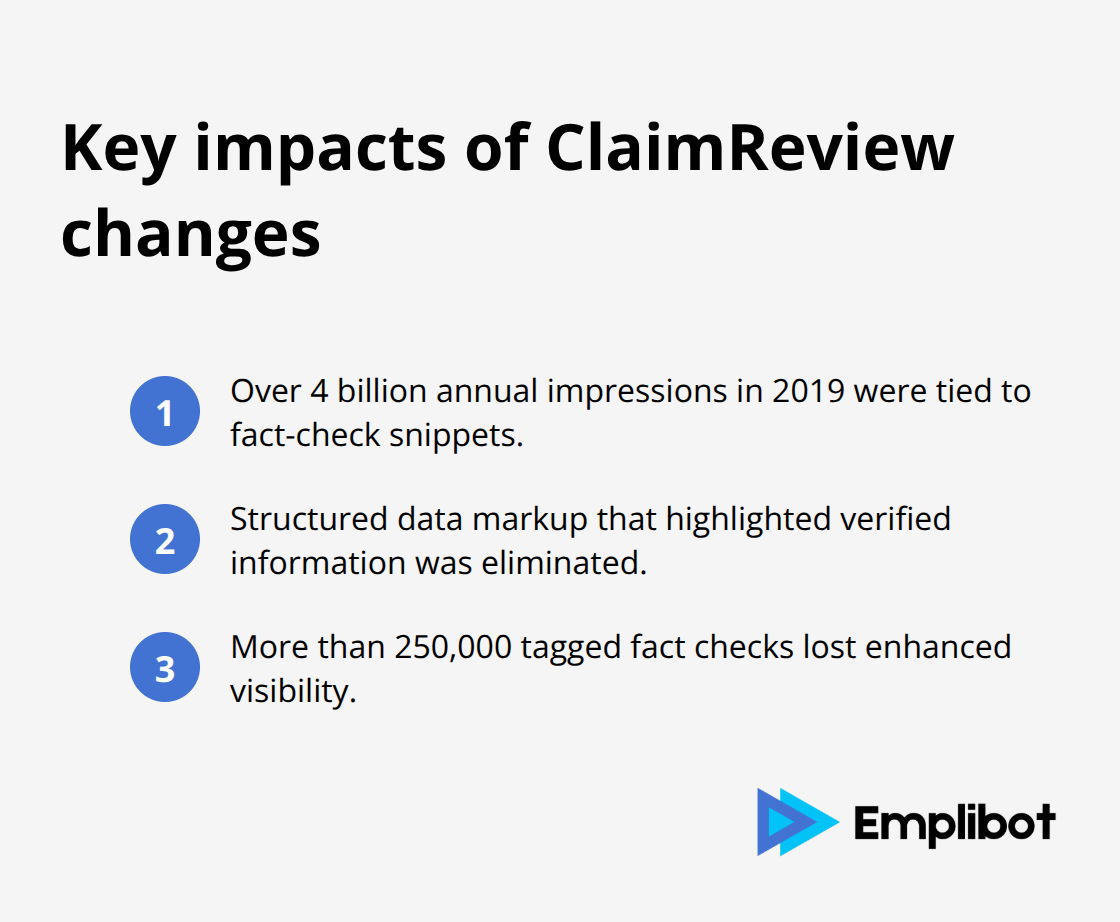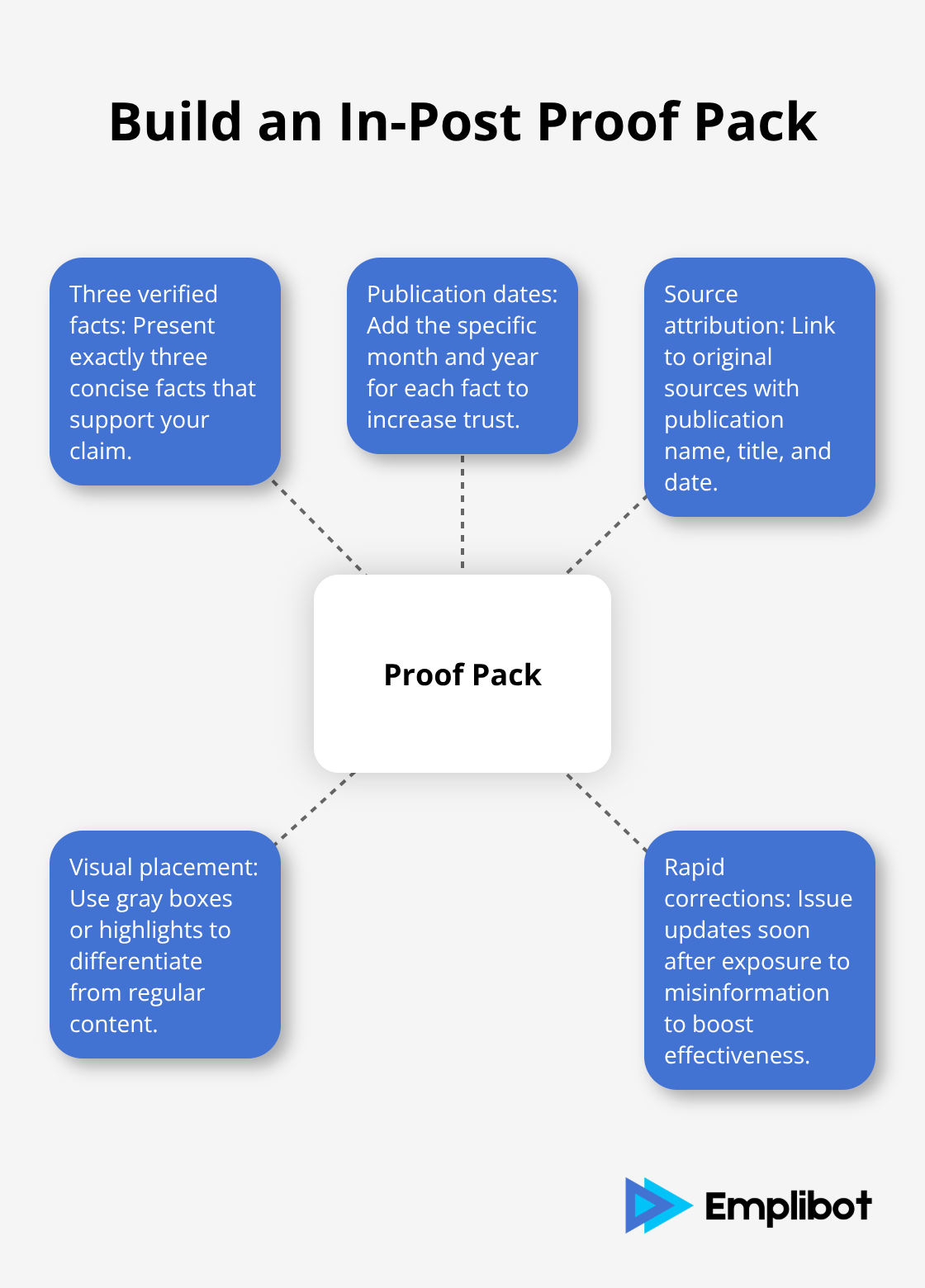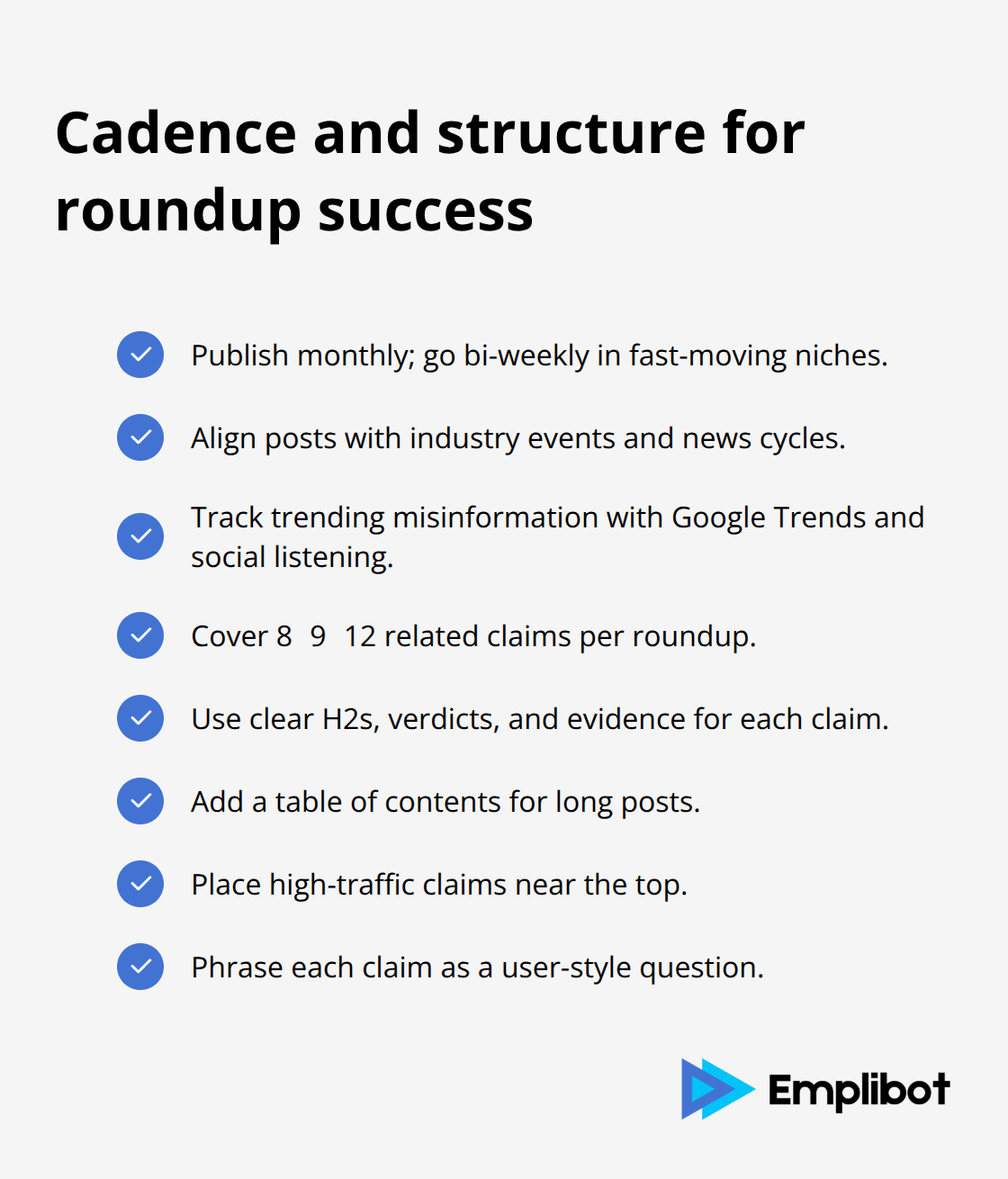Google altered fact-checking snippets in mid-2025, leaving publishers scrambling to maintain credibility. The ClaimReview snippets changed dramatically, removing the classic verification displays that readers trusted.
Content creators now face a new reality where traditional fact-checking signals no longer appear in search results. We at Emplibot have developed proven strategies to rebuild trust through in-post verification systems and strategic content approaches.
Contents
ToggleWhat Changed with Classic Fact-Checking Snippets
Google altered its ClaimReview program in mid-2025, removing fact-checking snippets that had served over 4 billion annual impressions in 2019. The search giant eliminated the structured data markup that highlighted verified information from sources like PolitiFact and The Washington Post Fact Checker, affecting more than 250,000 tagged fact checks.

Publishers lost their primary visibility mechanism for fact-checked content. Readers no longer see the familiar verification badges that distinguished credible sources from unverified claims. This change fundamentally altered how fact-checked information appears in search results.
Publishers Face Immediate Traffic Drops
Content creators experienced significant visibility losses when Google stopped its ClaimReview snippet display. Fact-checking organizations like Full Fact reported concerns about high-quality content getting pushed down search results without proper highlighting mechanisms.
The International Fact-Checking Network documented widespread dissatisfaction among fact-checkers who weren’t consulted about the termination. Publishers who had invested heavily in ClaimReview markup found their verification efforts suddenly invisible to searchers, forcing immediate strategy pivots to maintain credibility signals.
The Timeline Shows Strategic Corporate Retreat
Google’s ClaimReview retirement follows a broader pattern of tech companies that scale back third-party fact-checking initiatives. The decision occurred alongside increased complaints about search result quality due to spam and misinformation proliferation.
Major platforms simultaneously reduced their reliance on external verification partnerships. This corporate retreat from fact-checking support creates gaps that publishers must now fill independently through direct verification strategies and enhanced source attribution.
Search Results Become Less Reliable
The removal of ClaimReview contributes to what industry experts describe as a “hodgepodge” of search results. Researchers suggest that the increase in low-quality content online compounds the problem beyond just the ClaimReview removal.
Andrew Dudfield from Full Fact indicated that AI search overviews could push high-quality results further down the page without proper highlighting mechanisms. The decentralized nature of the internet means ClaimReview can still function on other platforms, though its primary search visibility advantage disappears.
Publishers now need new methods to signal content credibility and maintain reader trust in this changed landscape.
Building In-Post Proof Packs for Credibility
Publishers must create internal verification systems that replace Google’s removed ClaimReview snippets. The most effective approach involves proof packs that embed directly within your content, combining three verified facts with publication dates and source attribution. Research from the University of Cambridge shows that fact-checking involves predicting the veracity of claims using evidence, making proper verification essential for reader trust.
Create Dedicated Verification Sections
Build dedicated verification sections that appear immediately after you make factual claims. Each proof pack should contain exactly three facts with their publication dates, formatted consistently throughout your content. Multiple source verification strengthens credibility when publishers cross-reference claims across different platforms.
Place these blocks in gray boxes or highlighted sections to distinguish them from regular content. Include the specific month and year for each cited fact, as dates affect reader trust significantly. Research confirms that corrections work better when issued shortly after misinformation exposure, making date stamps essential for credibility.

Design Clear Verdict Statements
Transform your fact-check approach with definitive verdict boxes that appear prominently within your content. Each verdict should state clearly whether a claim is accurate, partially accurate, or false, followed by a one-sentence explanation. Automated fact-check tools continue improving, but human oversight remains necessary for complex political or scientific claims.
Position these verdict boxes immediately after your proof packs to create a logical flow from evidence to conclusion. Link directly to primary sources rather than secondary reports, and prioritize government databases, academic institutions, and established news organizations over forum discussions or social media posts.
Implement Source Attribution Standards
Establish consistent source attribution that readers can verify independently. Each fact within your proof packs needs a direct link to its original source, formatted with the publication name, article title, and exact date. This approach mirrors the transparency that ClaimReview snippets once provided but now operates under your direct control.
Create a standardized format for all source citations within your content. This consistency helps readers quickly identify and verify your claims while building long-term trust in your publication. Strategic fact-check roundups can amplify this approach across your entire content library.
Publishing Strategic Fact-Check Roundups
Strategic fact-check roundups consolidate multiple verification tasks into comprehensive posts that replace the visibility Google’s ClaimReview once provided. Publishers should create monthly or quarterly roundups that address the most disputed claims within their specific industry niche. Research from Harvard’s Misinformation Review demonstrates that systematic verification approaches work when applied consistently across related topics. Focus your roundups on claims that generate significant search volume and controversy within your field, as these posts capture readers actively seeking verification.
Target High-Volume Disputed Claims
Build your roundup strategy around claims that generate substantial search traffic and social media discussion. Research indicates that fact-checking articles experience increased frequency during major events like the COVID-19 pandemic and presidential elections, making timing essential for maximum impact. Track trending misinformation within your industry using Google Trends and social listening tools, then structure your roundups to address 8-12 related claims per post.
Each claim should receive the same proof pack treatment you use in regular content, with three verified facts, publication dates, and direct source links. Publishers who consistently address disputed claims within their niche build authority that search engines recognize even without ClaimReview markup.
Structure Posts for Maximum Search Visibility
Create roundup posts with clear H2 headings for each disputed claim, followed by your verdict and supporting evidence. Search engines favor content that directly answers user queries, so format each claim as a question that matches how people search for verification. Include a table of contents at the beginning of longer roundups (linking to specific claims within the post) to improve navigation.
This structure improves user experience while creating multiple internal anchor points that search engines can reference. Position your most controversial or high-traffic claims near the beginning of the post, as readers often abandon longer content before reaching the end.
Maintain Regular Publication Schedules
Regular publication schedules for these roundups signal to search engines that your site provides ongoing verification resources, improving your overall domain authority for fact-checking content. Monthly roundups work best for most industries, though sectors with rapid misinformation spread (like health or politics) may require bi-weekly updates.
Schedule your roundups to coincide with industry events or news cycles when disputed claims typically emerge. This timing strategy maximizes your content’s relevance and search visibility when readers most actively seek verification.

Final Thoughts
Publishers must adapt quickly to the post-ClaimReview landscape where traditional fact-check signals no longer exist in search results. The strategies outlined above provide concrete alternatives that maintain credibility without reliance on Google’s removed verification system. In-post proof packs and strategic roundups create sustainable verification methods that work independently of search engine changes.
Automation tools can streamline the fact-check process while they maintain accuracy standards. Emplibot automates WordPress blog content creation and SEO optimization, and it handles everything from keyword research to content distribution across social media platforms. This automation approach applies equally to fact-check content updates, which allows publishers to maintain regular verification schedules without overwhelming editorial teams.
The future belongs to publishers who control their own credibility signals rather than depend on external platforms. ClaimReview snippets changed the verification landscape permanently (but publishers who implement systematic proof packs and roundup strategies will maintain reader trust regardless of future search engine modifications). Success requires consistent application of these verification methods across all content, which creates a reputation for accuracy that transcends any single platform’s features.










